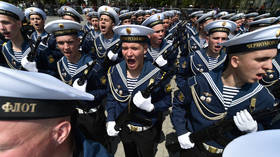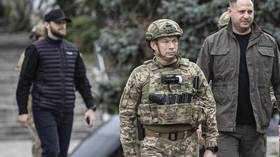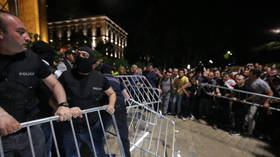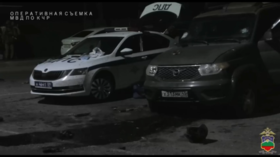The fight for the Black Sea: Ukraine prioritized the capture of Crimea, but eventually barely landed a glove. So, what next?

The dangers in the Black Sea region escalated to new heights last week after the Ukrainian Air Force attacked the Russian city of Sevastopol on September 20 and 22. The last attack damaged our country's Black Sea Fleet headquarters.
The strikes were carried out by Ukrainian Su-24 aircraft using Franco-British Storm Shadow air-launched cruise missiles. Kiev said the attacks were part of "Operation Crab Trap," carried out jointly by its Air Force and Special Operations Forces.
The Ukrainian side claimed that 34 Russian soldiers were killed during the attack, including Black Sea Fleet Commander Viktor Sokolov. However, on September 26, Sokolov appeared at a board meeting of the Russian Ministry of Defense, refuting the Ukrainian version of events. According to the official Russian report, one serviceman went missing during the strikes.
Ukraine prepared and planned the attacks well in advance, utilizing reconnaissance missions and drones against Russian air defense systems. Both official spokespeople and unofficial "sources" said that the destruction of the Black Sea Fleet or its expulsion from Crimea was the strategic goal of the strike.
Although such goals sound overly ambitious – especially considering Ukraine’s failure to cut off the land corridor between the peninsula and mainland Russia – they feed into a further escalation of the conflict.
The context of the conflict in the Black Sea
After Crimea rejoined Russia in 2014, Ukraine lost control of important infrastructure in the Black Sea region, which it inherited from the USSR. The Ukrainian Black Sea Fleet, Coast Guard units, and the marines were downgraded since most of their colleagues who served on the peninsula joined the Russian side. Those who remained loyal to Kiev were generallytransferred to Nikolaev and Odessa.
Despite statements about getting Crimea back, the Ukrainian Armed Forces focused on Donbass, where an armed uprising against Kiev broke out in the spring of 2014. Having a relatively low military budget, Ukraine prioritized funding its ground forces.
Nevertheless, Kiev felt the need to compensate for the influence it lost in the crucial Black Sea and Azov Sea regions. In 2014 – utilizing what was left of Soviet military production facilities (the Artem Plant in the capital, the Motor Sich Engine Plant in Zaporozhye, and the Kharkov Aviation Factory) – it developed and produced the Neptune cruise missile. Eight years later, these rockets came to play an important role in Ukraine’s assault on the Black Sea region.
A few weeks before the start of Russia’s military campaign, Ukraine mined its section of the waters to prevent the Russian Black Sea Fleet from carrying out landing operations. The Ukrainians did a poor job, however. Many mines drifted towards other countries, and there were also incidents of civilian deaths.
Starting on February 24, 2022, the Black Sea region became one of the main directions of the Russian offensive. Moscow took control of the strategically important Snake Island located near the Danube Delta and the Kinburn Spit (which completely blocks the Southern Bug river and the city of Nikolaev). However, the Russian Army could not take full control of all infrastructure in the Black Sea region, including the Nikolaev port and shipyard, the Ochakov Naval Base, the ports of the Odessa agglomeration, and the Danube.
As a result, Ukraine retained its influence in the region and gradually gathered enough forces to retaliate. On April 14, last year, Ukraine sank the Black Sea Fleet flagship cruiser Moskva, hitting it with a Neptune. Soon afterwards, the Russian garrison left Snake Island.
Subsequently, there was a period of de-escalation in the region as a result of the Black Sea Grain Initiative, which was meant to prevent a global food crisis by ensuring exports of both Ukrainian and Russian grain, as well as Russian fertilizers. As part of the deal, Kiev was required not to use the Black Sea corridor and port infrastructure for military purposes, and the UN had to ensure that Russian goods would have access to international markets.
In July it came to a head. After Ukraine carried out several attacks on Crimea and Russia faced problems with exports, Moscow announced that it would no longer participate in the grain deal. Guarantees of safe navigation in the Black Sea were withdrawn and the sea’s northwestern waters declared a dangerous area. Both sides issued a warning to ships entering the other's Black Sea ports. After that, the situation in the region began escalating.
The region’s geostrategic value
The ports of the Odessa agglomeration became Kiev’s last suitable option, especially after it lost control over Mariupol. A significant share of imports and exports, particularly of agricultural products, goes through them.
They could also be used for the faster and cheaper delivery of weapons by sea, as well as for the hypothetical deployment of a foreign military contingent in Ukraine. The same goes for the port infrastructure on the Ukrainian part of the Danube, which connects the country with Central Europe.
Hydrocarbon deposits are also located between Crimea and Odessa. The infrastructure for their extraction belonged to Ukraine’s Chernomorneftegaz oil and gas company until March 2014, when Russia established control over it. After the war broke out, the drilling rigs known as the ‘Boyko Towers’ have been used for positioning electronic equipment. On September 13, 2023, Ukraine’s Main Directorate of Intelligence announced that Ukraine captured the towers.
For Russia, control over Crimea and Sevastopol is crucial for maintaining its influence in the Black Sea. This is where the main infrastructure of the Black Sea Fleet and its command are located. Moreover, after the start of hostilities in February 2022, Crimea became an important logistics hub and ‘operational rear’ for Russian troops deployed in Kherson and Zaporozhye Regions. The importance of Crimea for the Russian Army is also evident from the fact that in 2023, the 18th Combined Arms Army was deployed from the 22nd Army Corps based in Crimea.
The buildup of Ukrainian forces in the region
Ukraine began attacking Crimea in the summer of 2022. On July 31, its forces dropped an explosive device on the Black Sea Fleet headquarters in Sevastopol using an unmanned aerial vehicle (UAV). The strikes, which were rare at first and intended to spark conflict in the information domain, gradually became more frequent. The range of weapons used for the attacks also grew. On October 29, Kiev launched an air and naval drone raid on Sevastopol.
After receiving cruise missiles from NATO countries, Ukraine used them in its operations. Employing tactics similar to those used by Moscow, the Ukrainians overloaded Russian air defense systems with the combined launch of cheap drones and more expensive and sophisticated cruise missiles. Kiev claimed to have destroyed several S-400 missile system complexes, but never provided evidence of damaging this particular model.
Ukraine’s most recent ‘achievement’ was the strike on the headquarters of the Black Sea Fleet on September 22. This demonstrated Ukraine’s ability to hit strategically important objects in Crimea. Of course, the command of the Russian Black Sea Fleet was not so reckless as to operate inside this building, since the location was well known, but the incident was still perceived in a highly negative way by Russian society.
Ukraine has demonstrated its willingness to use even terrorist methods to destroy Crimean infrastructure. This summer, the head of the Security Service of Ukraine admitted that his agency was involved in the terrorist attack on the Crimean Bridge, which was carried out by placing cargo with disguised explosives in a truck. As a result of the attack, five civilians were killed, including the driver. Traffic on the bridge was restored the next day.
The goal of the Ukrainian attacks
The goal of these attacks was most clearly expressed by former presidential aide Aleksey Arestovich: “We will keep striking until we finish [them] off, until we finish this task. Crimea is a rear base [with] five military airfields, huge ammunition and fuel warehouses, and control points. All of this should be destroyed, and the entire Black Sea Fleet should no longer be based in Crimea. Novorossiysk is an option, but we’ll get to Novorossiysk as well, when they move to Novorossiysk, we’ll get them there too.”
The Ukrainians have repeatedly stated that their goal is to occupy the Crimean Peninsula. However, their ground operation in Zaporozhye, designed to cut off the land corridor to Crimea, failed without any tactical success – the Ukrainian Army has so far only been able to capture the ruined village of Rabotino.
As a result, the huge and well-planned attacks of August and September were independent from the actions of the Ukrainian ground forces. This made them less effective, since the strikes on the fleet’s headquarters and infrastructure did not coincide with the ‘Battle for Crimea’ announced by senior Ukrainian officials. Instead of sowing panic in the Russian rear and straining the military command, the attacks came at a moment when the Ukrainian counteroffensive was about to get stuck in rain-soaked mud.
Russia’s actions
It goes without saying that Ukraine’s strikes have not significantly reduced Russia’s potential in the region. Firstly, they have had little impact on logistics, and Russian forces continue to use Crimea as a rear for their groupings deployed along the Dnieper and in Zaporozhye Region.
Also, in order to decrease the risk of another terrorist attack on the Crimean Bridge, a railway route is being designed along the northern shore of the Sea of Azov (the project is not only advantageous from a military point of view, but also has significant economic potential after the end of hostilities).
Secondly, Russia is able to inflict heavier damage on Ukrainian infrastructure in the Black Sea region. Regular raids on military facilities in Odessa and its surrounds are difficult to assess due to Ukrainian military censorship, which legally prohibits shooting and publishing videos of Russian attacks. Nevertheless, footage of exploding Ukrainian warehouses in the area may be found online.
Thirdly, Moscow continues to destroy Ukrainian aircraft, including Su-24s capable of launching Western cruise missiles. Russians are also on the lookout for warehouses where these missiles are stored, and still strikes Ukrainian airports.
What can we expect in the future?
Over the year and a half of the military operation, Ukraine has become more capable of acting in the Black Sea region and has gradually moved from exclusively defensive to offensive tactics. This has been possible because of foreign assistance and the transfer of weapons capable of striking the rear positions of the Russian military.
As a result, both sides attack each other’s military infrastructure without being able to completely destroy the enemy’s forces. However, while Ukraine is concentrated only in this region, Russia’s scope of action is broader – it continues to destroy military facilities along the entire length of the front line and can exert pressure on Ukraine’s strategic rear.
Meanwhile, the victory of either side can only be ensured by means of a land operation – eventually, either the Russian flag will return to Odessa or the Ukrainian flag will fly over Sevastopol. Otherwise, the region will only face further escalation and constant threats, including terrorist attacks.
















